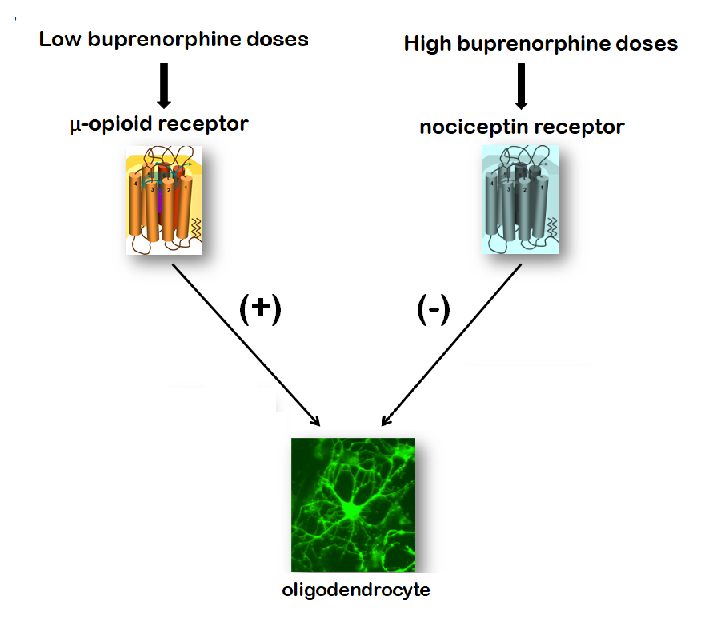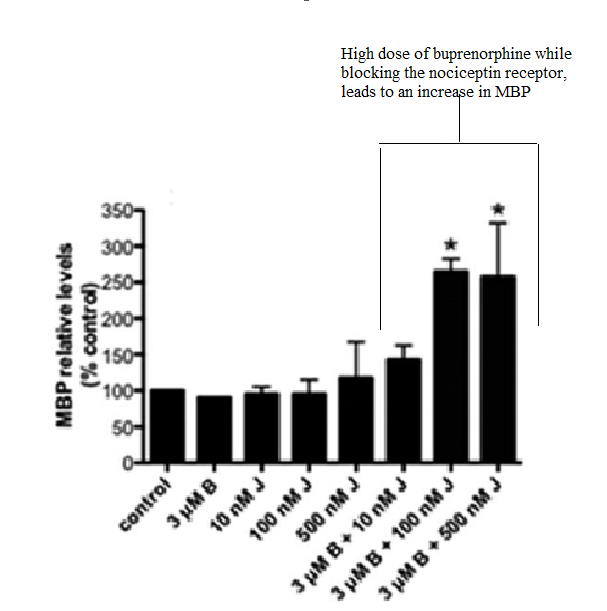Journal of Comprehensible Results
Sanchez E, Bigbee J, Fobbs W, Robinson S, Sato-Bigbee C (2008)
Opioid Addiction and Pregnancy:Perinatal Exposure to Buprenorphine
Affects Myelination in the Developing Brain.
Glia 56:1010-1027
Opioid Addiction and Pregnancy:Perinatal Exposure to Buprenorphine
Affects Myelination in the Developing Brain.
Glia 56:1010-1027
(Translated by Brenna Kent)
Implications: Biphasic Dose Response
|
For all age groups, MBP increased when exposed to 0.3 mg/kg/day and decreased when exposed to 1 mg/kg/day. This relationship is also seen in the levels of MAG for the 26 day age group which is indicative of a biphasic dose response curve. This could either be the direct result of buprenorphine interacting with the oligodendrocytes or through indirect interactions with other cells. Eschenroeder et al (2012) sought to understand whether or not the biphasic response was caused by direct or indirect affects of the buprenorphine. In order, to determine if buprenorphine had a direct affect, cultured oligodendrocytes in the absence of other cells associated with the central nervous system were exposed to buprenorphine. Once again, an increase in myelin basic proteins was seen at low doses, but not at high doses. This supported the idea that buprenorphine is directly acting on the oligodendrocytes and its affects are not mediated through another cell type.
|

Fig. 11: Representation of the mu and nociceptin receptors The mu receptor is activated at low doses and leads to an increase in MBPs; whereas, the nociceptin receptor is activated at high doses and decreases MBPs expression.
Adapted from "Oligodendrocyte responses to buprenorphine uncover novel and opposing roles of mu opioid and nociceptin/orphanin FQ receptors in cell development: Implications for drug addiction treatment during pregnancy." by Eschenroeder, A. C., Vestal-Laborde, A. A., Sanchez, E. S., Robinson, S. E. and Sato-Bigbee, C., 2012, GLIA, 60, p. 133. Copyright 2011 by Wiley Periodicals, Inc. |
|
Buprenorphine affects oligodendrocytes by binding to opioid receptors. Two receptors of interest are the mu opioid receptor and the nociceptin receptor which are both present on oligodendrocytes. It is already known the buprenorphine is a mu partial agonist, meaning that it increases expression, but not much was known about the role of the nocicpetin receptor. When a nociciptin inhibitor was introduced, then there was no decrease in the levels of MBPs; instead the levels of MBPs continued to increase with an increase in buprenorphine (Fig. 12). This indicates that the nociceptin receptor is responsible for the biphasic does response curve that is typically observed[8].

Fig. 12: Relative levels of MBPs at different levels of buprenorphine and in the presence or absence of the nociceptin inhibitor, J. In the presence of the nociceptin inhibitor, the level of myelin basic proteins continues to increase as buprenorphine dose increases instead of decreasing which is normally observed.
Adapted from "Oligodendrocyte responses to buprenorphine uncover novel and opposing roles of mu opioid and nociceptin/orphanin FQ receptors in cell development: Implications for drug addiction treatment during pregnancy." by Eschenroeder, A. C., Vestal-Laborde, A. A., Sanchez, E. S., Robinson, S. E. and Sato-Bigbee, C., 2012, GLIA, 60, p. 132. Copyright 2011 by Wiley Periodicals, Inc. |